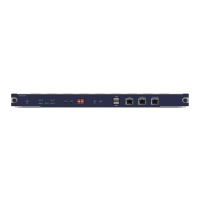ZXR10 GER (V2.6.03) General Excellent Router User Manual Volume-I
312 Confidential and Proprietary Information of ZTE CORPORATION
This is a significant improvement over hub-and-spoke
architectures used by Frame Relay and other technologies. Hub-
and-spoke architectures require the end user to designate one
customer edge node as the "hub" that is connected to all
"spoke" sites. All communication between sites first must go
through the spoke site, leading to potential bottlenecks and
other performance problems.
With VPLS, each customer edge device only requires a single
connection to the provider edge, and the provider edge provides
full multipoint connectivity. A VPLS consists of a collection of
customer sites connected to provider edge devices that are
implementing the emulated LAN service.
A virtual switching instance (VSI) is used at each VPLS provider
edge router to implement the forwarding decisions of each VPLS.
The provider edge devices make the forwarding decisions
between sites and encapsulate the Ethernet frames across a
packet-switched network using an Ethernet pseudowire. Provider
edge routers use a full mesh of pseudo-wires to forward the
Ethernet frames between provider edge nodes.
In a VPLS, each device can communicate directly with its peers,
which is efficient for applications that must be propagated
quickly throughout the network, such as broadcast and
distributed ERP. Scalability and manageability are limited,
however-the amount of overhead increases exponentially
because packets sent to all devices in a broadcast, for example,
must be replicated for the number of devices receiving them.
Depending on the type of VPLS application, MAC address
learning and broadcast packet replication can become
problematic.
VPLS Service Configuration
The latest breakthrough in MPLS development is called Virtual
Private LAN Service (VPLS), paying due respect to Ethernet
technology.
Main idea is using IP/MPLS routing protocols instead of
conventional Spanning Tree algorithm and its known
shortcomings, and the use of MPLS labels to replace now
“traditional” VLAN Ids. Ethernet frames are switched on basis of
their Layer 2 (MAC) address. The major advantage here is the
possibility of a point-to-multipoint interconnection, just as in the
case of a local network (Bridged or Switched LAN).
In the MPLS/IP core transport network, VPLS support Ethernet
transmission service in layer2.
This procedure describes how to do VPLS configuration on ZTE
ZXR10 GER.
Router Command Line Interface has been accessed.
Virtual
Switching
Instance (VSI)
Background
Purpose
Prerequisite
Steps

